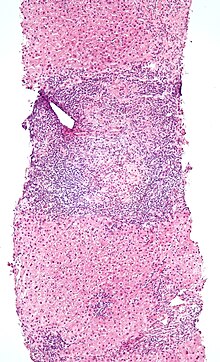Intraepithelial lymphocytes (IEL) are lymphocytes found in the epithelial layer of mammalian mucosal linings, such as the gastrointestinal (GI) tract and reproductive tract.[1] However, unlike other T cells, IELs do not need priming. Upon encountering antigens, they immediately release cytokines and cause killing of infected target cells. In the GI tract, they are components of gut-associated lymphoid tissue (GALT).[2]
Intestinal IELs are long-lived resistant effector cells spread along the entire length of intestine, where they patrol the space between intestinal epithelial cells (IEC) and the basement membrane (the intraepithelial space). Epithelium of small intestine contains approximately 1 IEL per 10 enterocytes.[3] Due to their constant exposure to of antigens at mucosal barrier, they have unique antigen-experienced activated phenotypes and they constantly express CD103 (αE integrin), that is distinct from the conventional T cells in the intestine.[3] IELs are mainly T cells with mixture of subsets. They are divided into two groups – conventional and unconventional IELs.[4]
In mice both groups are retained in almost equal proportions.[5] In humans, the majority of IELs are alpha beta T cells. 15% of IELs are gamma delta T cells and thus represent a minor component of human IELs. However, IELs significantly increase under certain conditions, such as celiac disease.[1]

- ^ a b Cite error: The named reference
pmid16787773was invoked but never defined (see the help page). - ^ DeFranco AL, Locksley RM, Robertson M (2007). The Immune Response in Infection and Inflammatory Disease. London: New Science Press. pp. 218–219. ISBN 978-0-19-920614-8.
- ^ a b Olivares-Villagómez D, Van Kaer L (April 2018). "Intestinal Intraepithelial Lymphocytes: Sentinels of the Mucosal Barrier". Trends in Immunology. 39 (4): 264–275. doi:10.1016/j.it.2017.11.003. PMC 8056148. PMID 29221933.
- ^ Cite error: The named reference
:8was invoked but never defined (see the help page). - ^ Sheridan BS, Lefrançois L (December 2010). "Intraepithelial lymphocytes: to serve and protect". Current Gastroenterology Reports. 12 (6): 513–521. doi:10.1007/s11894-010-0148-6. PMC 3224371. PMID 20890736.